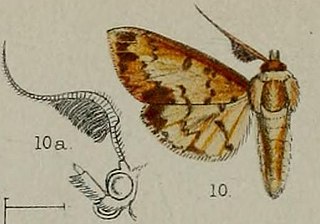Haritalodes polycymalis is a moth in the family Crambidae. It was described by George Hampson in 1912. It is found in the Democratic Republic of the Congo, Guinea, Ivory Coast, Kenya, Madagascar, Malawi, Mozambique, Sierra Leone, South Africa (KwaZulu-Natal), Tanzania and Uganda.
Syllepte albirivalis is a moth in the family Crambidae. It was described by George Hampson in 1912. It is found in Papua New Guinea.
Syllepte leucographalis is a moth in the family Crambidae. It was described by George Hampson in 1912. It is found in Indonesia (Bali).
Syllepte microdontalis is a moth in the family Crambidae. It was described by George Hampson in 1912. It is found in French Guiana.
Syllepte microspilalis is a moth in the family Crambidae. It was described by George Hampson in 1912. It is found in Singapore.
Syllepte disciselenalis is a moth in the family Crambidae. It was described by George Hampson in 1918. It is found in Malawi.
Syllepte orbiferalis is a moth in the family Crambidae. It was described by George Hampson in 1898. It is found on Réunion and in South Africa.

Syllepte plumifera is a moth in the family Crambidae. It was described by George Hampson in 1898. It is found in Indonesia and Papua New Guinea, where it has been recorded from the D'Entrecasteaux Islands.
Syllepte eriopisalis is a moth in the family Crambidae. It was described by Francis Walker in 1859. It is found on Borneo and in India.
Syllepte melanopalis is a moth in the family Crambidae. It was described by George Hampson in 1908. It is endemic to Mayotte in the Indian Ocean off the coast of southeast Africa.
Syllepte ochrifusalis is a moth in the family Crambidae. It was described by George Hampson in 1899. It is found in Papua New Guinea, where it has been recorded from the D'Entrecasteaux Islands.
Syngamia albiceps is a moth in the family Crambidae. It was described by George Hampson in 1912. It is found in Singapore.
Tatobotys albivenalis is a moth in the family Crambidae. It was described by George Hampson in 1897. It is found in Japan's Ogasawara Islands.
Syllepte pogonodes is a moth in the family Crambidae. It was described by George Hampson in 1899. It is found in Indonesia.
Syllepte proctizonalis is a moth in the family Crambidae. It was described by George Hampson in 1918. It is found in China.
Udea fusculalis is a moth in the family Crambidae. It was described by George Hampson in 1899. It is found in Mexico (Orizaba), Peru and Loja Province, Ecuador.
Udea umbriferalis is a moth in the family Crambidae. It was described by George Hampson in 1918. It is found in Peru and Bolivia.
Ulopeza denticulalis is a moth in the family Crambidae. It was described by George Hampson in 1912. It is found in South Africa.
Ambia mesoscotalis is a moth in the family Crambidae. It is found in Indonesia, where it has been recorded from the Maluku Islands (Banda).
Ambia vagilinealis is a moth in the family Crambidae. It is found in Papua New Guinea.
